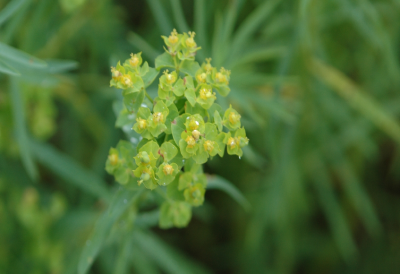Leafy Spurge – Expensive Beauty
Leafy Spurge Description
If painting wildflowers is one of your hobbies, you can’t find many a scene lovelier than a field full of leafy spurge. The plant’s blossoms are reminiscent of a yellow violet – soft overlapping petals and a tiny bud in the center that is pinkish orange. Stalks of thin green leaves give the plant a bushy appearance that begs to be sketched or painted.
The problem is that leafy spurge isn’t a wildflower, it’s one of Colorado’s noxious weeds and its spread into rangeland is costing ranchers money. According to the Colorado State University Extension, leafy spurge “can reduce cattle carrying capacity of rangeland or pastures by 50 to 75 percent” in part by decreasing grass production. The other issue is that cattle don’t like to graze in large expanses of the weed.
Leafy Spurge Reproduction
The plant reproduces by both seeds and root runners. Its stands – areas of land that are almost entirely covered – seem to pop up overnight. One reason for the quick growth is that leafy spurge is a very healthy weed. It is able to store nutrients within its root system to survive the  effects of drought. So while some weeds may slow their growth to conserve energy stores, leafy spurge just keeps going, sending shoots up through the ground as roots creep down below.
effects of drought. So while some weeds may slow their growth to conserve energy stores, leafy spurge just keeps going, sending shoots up through the ground as roots creep down below.
Leafy spurge seeds have their own survival techniques. Each flower on a plant can produce up to 140 seeds. When seed capsules dry, seeds can be expelled up to 15 feet from the parent plant. Immediate germination isn’t necessary for the paratrooper seeds since they remain viable for up to eight years after launch.
SprayTech, Colorado commercial and residential weed control experts, can help you identify and treat leafy spurge on your property. Call them at 720-248-0000 to discuss a plan of action.


Comments are closed.